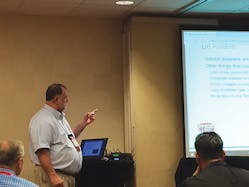SAN ANTONIO, TEXAS — Think your firm is prepared for a natural disaster? You probably aren’t even if you think you are; that was the experience at Integrated Facilities Services, a large St. Louis-area mechanical contractor that had to deal with a flood, the contractor’s general manager, Malcolm Sweet, told contractors here.
Sweet spoke during the Plumbing-Heating-Cooling Contractors — National Association CONNECT 2016 conference and show here in mid-October.
There are many disasters that can hit contractors — tornadoes, earthquakes, floods, wildfires and even acts of terrorism. If your business experiences an earthquake, the damage to your building is bad enough, Sweet noted, but what if the earthquake knocks out the bridges and you can’t get to your building?
A typical business interruption for a mid-size business costs $8,500 an hour and lasts for an average of a day and a half, Sweet said. That’s far less than what Integrated Facilities Services dealt with; the last of its people weren’t back in the building for four months.
And it could have been much worse. When the Merrimack River, a tributary of the Mississippi, went over its banks in late December 2015, Integrated Facilities Services had 22-inches of floodwater in its first floor. A competitor downriver got eight feet.
IFS was in better shape than most contractors to deal with a disaster. They are a large and prosperous contractor with available cash, plus they had $1 million in flood insurance, which proved to be too little. Their flood insurance was split between $500,000 for the building and $500,000 for its contents. FEMA draws a hard line between those two so you can’t spend insurance money allocated to one on the other.
Integrated Facilities Services had a 65,000-sq.ft. building, with about 20,000-sq.ft. of office and the balance in the service department and estimating, plus shops for sheet metal and piping fabrication. Unlike some other disasters, such as a tornado, a flood happens in slow motion, giving IFS time to move all of its computers to the second floor.
FEMA mandated that they strip the building to 4-ft. above the floor. Fortunately, the electrical service was overhead so they only had to replace the receptacles. It took two days to strip the building. It took four to five days to dehumidify the building and trailer-mounted dehumidifiers rent for $50,000 a day.
IFS thought that they could clean its metal office furniture, but metal office furniture is made of hollow tubes. A nearby sewage treatment plant also flooded, so the furniture was filled with highly contaminated sludge. They had to trash office furniture for 35 people.
Sweet said that the $500,000 in flood insurance on the building was spent long before they moved back in. Fortunately, IFS had the cash on hand to pay for the rest of it, so the firm decided the flood had given it the opportunity to rearrange the layout of the building. Many of its employees worked remotely for as long as four months, so they had to set up methods to allow them to do that, such as a VPN, plus a way to monitor its employees’ activity.
Recovering from the flood turned out to be a much bigger project than Integrated Facilities Services expected, Sweet said, and it left them with a lot of lessons.
Contractors need to focus on the top two or three most likely disasters, Sweet advised, such as tornadoes in the Midwest. Contractors need to determine what functions are critical: G&A, payroll, phones and service dispatching, and so on. What would be needed to get through the first two weeks after a disaster? It should be planned with the same level of detail as a construction project, Sweet said.
You need a written disaster plan. You’ll need insurance. Sweet said that IFS has increased its flood insurance to $2.5 million each for the building and its contents, because they burned through the $500,000 for the building so quickly. You need money. Do you have cash or a line of credit? Can you tap into Federal disaster funds? You need friends. Is there another firm across town that could, for example, let you use their pipe fab shop? You need to make sure that subcontractors and employees know what to expect; Sweet advised daily updates. And you need your computers and software set up so that you have cloud storage and the ability for employees to work from home.
Are you going to rebuild? The same? Different? Completely different? Is your current building code compliant or would it need substantial upgrades? Would you move? Where? A new or existing building?
Whatever you decide to do, the process takes time, Sweet advised, so this all has to be thought out in advance.



